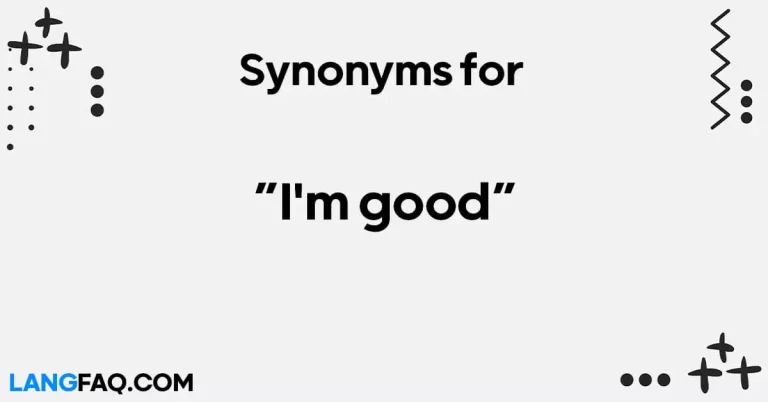In the dynamic landscape of professional communication, expressing uncertainty is inevitable. Mastering the art of conveying uncertainty with finesse is crucial for effective workplace interactions. This article unveils 12 alternative ways to say “I am not sure” professionally, providing insights to elevate your communication skills. Embrace these phrases to navigate uncertainties confidently and contribute positively to your professional environment.
12 Other Ways to Say “I Am Not Sure” Professionally
Here are 12 other ways to say “I am not sure” professionally:
- I need to verify that.
- I’ll confirm the details.
- I’m exercising caution before confirming.
- I’m approaching this with care.
- I’ll investigate and provide an update.
- Let me delve deeper into this matter.
- I’ll seek clarification and revert.
- I’ll clarify the details shortly.
- I’ll conduct thorough research and provide insights.
- For now, let’s consider this a tentative answer.
- Ongoing analysis is underway, and I’ll keep you informed.
- If all goes as planned, we should have a resolution soon.
Here’s a table with meanings and examples for the 12 other ways to say “I am not sure” professionally:
| Expression | Meaning | Example |
|---|---|---|
| I need to verify that. | Needing to check and confirm information. | “Before providing an answer, I need to verify that data.” |
| I’ll confirm the details. | Assuring to check and validate specific information. | “Let me gather the information, and I’ll confirm the details.” |
| I’m exercising caution before confirming. | Approaching the situation with careful consideration. | “Given the complexity, I’m exercising caution before confirming.” |
| I’m approaching this with care. | Handling the matter with thoroughness and attention. | “I appreciate your question; I’m approaching this with care to provide accurate information.” |
| I’ll investigate and provide an update. | Conducting a thorough examination and sharing findings. | “I’ll investigate the issue and provide you with an update shortly.” |
| Let me delve deeper into this matter. | Exploring the subject more profoundly for better insight. | “Your inquiry is significant, and I’ll delve deeper into this matter for a comprehensive response.” |
| I’ll seek clarification and revert. | Seeking additional information before responding. | “I’ll seek clarification from the team and revert with a detailed response.” |
| I’ll clarify the details shortly. | Promising to provide clear and concise information soon. | “Your question is valid; I’ll clarify the details shortly.” |
| I’ll conduct thorough research and provide insights. | Committing to in-depth research for a comprehensive answer. | “To address your query accurately, I’ll conduct thorough research and provide insightful information.” |
| For now, let’s consider this a tentative answer. | Offering a temporary response pending further investigation. | “Given the circumstances, for now, let’s consider this a tentative answer until we gather more information.” |
| Ongoing analysis is underway, and I’ll keep you informed. | Communicating active monitoring and commitment to updates. | “Rest assured, ongoing analysis is underway, and I’ll keep you informed as the situation evolves.” |
| If all goes as planned, we should have a resolution soon. | Expressing optimism about a potential timely solution. | “Assuming no unexpected challenges, if all goes as planned, we should have a resolution soon.” |
This diverse array of professional expressions goes beyond a simple “I am not sure,” offering nuanced ways to convey uncertainty while maintaining a polished and confident demeanor. Whether exercising caution, seeking clarification, or committing to thorough research, these alternatives provide a toolkit for effective communication in various workplace scenarios. By integrating these phrases into your professional repertoire, you not only navigate uncertainties gracefully but also contribute to a positive and solution-oriented work environment.
Is It Correct to Say “I Am Not Sure”?
Questioning the Ubiquitous: “I Am Not Sure”
The phrase “I am not sure” is a common go-to response in various situations, but is it always the most effective way to communicate uncertainty? Let’s explore the nuances and alternatives to ensure your expressions align with different contexts.
Is the Familiar Always Optimal?
Scenario: In professional settings, the straightforward “I am not sure” might be perceived as lacking confidence. Considering alternatives can add depth to your responses.
Example Sentence: “While I lack the complete details presently, I’m actively working to gather the necessary information for an accurate response.”
Asserting Confidence Amid Uncertainty
Scenario: In situations demanding assurance, conveying uncertainty with confidence becomes paramount. Phrases like “I’m currently verifying the details” or “I’m in the process of confirming” can replace the conventional.
Example Sentence: “To ensure precision, I’m in the process of confirming the details and will update you shortly.”
Balancing Caution in Collaboration
Scenario: When interacting with colleagues, expressions that convey caution without signaling hesitation can be beneficial. Phrases like “I’m exercising caution before confirming” strike a balance.
Example Sentence: “While I appreciate the urgency, I’m exercising caution before confirming to guarantee well-informed decisions.”
Seeking Clarity with Professionalism
Scenario: Inquiries requiring more context can be addressed with phrases like “I’ll seek clarification and revert.” This shows a commitment to clear communication.
Example Sentence: “Your question is valid; for clarity, I’ll seek additional information and revert with a comprehensive response.”
Embracing Proactive Transparency
Scenario: In fast-paced situations, offering a tentative answer while expressing ongoing efforts to gather more information can be effective.
Example Sentence: “For now, let’s consider this a tentative answer. I’m actively working on gathering all the necessary information for a more detailed response.”
Professional Mail Example With “I Am Not Sure”
Subject: Clarification on Project Timeline
Dear [Recipient’s Name],
I trust this email finds you well. I am reaching out to address a query regarding the timeline for the upcoming project. While I have made significant progress in outlining the key milestones, I am currently awaiting some crucial information that would allow me to provide a more precise estimate.
At this moment, I want to be transparent about the uncertainty surrounding the specific timeframe. I am not sure about the exact dates due to the ongoing data collection process and the need for validation. However, rest assured that I am actively working on securing the necessary details to offer a more accurate projection.
I understand the importance of having a clear timeline for planning purposes, and I appreciate your patience as we navigate through these final stages of preparation. In the interim, if there are any specific aspects or concerns you would like me to address, please feel free to share them, and I will prioritize them in my current efforts.
Thank you for your understanding, and I will keep you updated on the progress and provide a more definitive timeline as soon as the required information is confirmed.
Best Regards,
[Your Full Name] [Your Position] [Your Company] [Contact Information]
Navigating Uncertainty in the Workplace
Navigating uncertainties in the workplace requires finesse and effective communication. One powerful way to convey uncertainty professionally is by using the phrase “I need to verify that.” This expression not only acknowledges the uncertainty but also assures a commitment to accuracy.
Scenario: Imagine a colleague asking about a specific project deadline. In this formal context, you might respond, “I need to verify that with the project manager to ensure I provide you with the most accurate information.”
Example Sentence: “I appreciate your inquiry; however, to provide you with precise details, I need to verify that with the relevant team members.”
Email Sample:
Subject: Clarification on Project Deadline
Dear [Colleague’s Name],
Thank you for reaching out regarding the project deadline. I understand the importance of the timeline. Before confirming, I need to verify the details with the project manager to ensure accuracy. I’ll revert to you with the confirmed information shortly.
Best regards, [Your Name]
Variations:
- Colleague: “I’ll confirm that with the team lead and get back to you.”
- Friend: “Let me double-check with others and I’ll give you the scoop.”
- Mentor-Mentee: “Before providing a definite answer, I’ll verify that with our senior advisor.”
Dictionary Insight: According to the Cambridge Dictionary, “verify” means to prove that something exists or is true, or to make certain that something is correct.
Pros:
- Demonstrates commitment to accuracy.
- Shows professionalism in handling uncertainties.
Cons:
- May slightly extend response time due to the need for verification.
Tips:
- Use this phrase when precision is crucial.
- Follow up promptly after verification to maintain efficiency.
Expressing Caution with Diplomacy
When caution is warranted, expressing it professionally is essential. The phrase “I’m exercising caution before confirming” not only communicates prudence but also assures stakeholders that you prioritize accuracy over speed.
Scenario: Picture a situation where a team member seeks immediate approval for a project strategy. In this formal setting, your response might be, “Given the complexity of the situation, I’m exercising caution before confirming. I want to ensure we consider all potential outcomes.”
Example Sentence: “While I understand the urgency, I’m exercising caution before confirming to guarantee we make well-informed decisions.”
Email Sample:
Subject: Cautionary Approach to Project Strategy
Dear [Team Member’s Name],
Thank you for presenting the project strategy. Given the complexity of the situation, I’m exercising caution before confirming. I believe it’s crucial to consider all potential outcomes before proceeding. I’ll provide you with a detailed analysis by [specified time].
Best regards, [Your Name]
Variations:
- Colleague: “I’ll be cautious in endorsing this approach until we assess potential risks.”
- Friend: “I want to exercise caution before committing to the weekend plan; there might be unexpected changes.”
- Mentor-Mentee: “Exercising caution is a crucial skill in decision-making. I recommend thoroughly analyzing the situation before confirming.”
Dictionary Insight: The term “exercise caution” is synonymous with being careful and taking preventive measures to avoid potential issues.
Pros:
- Establishes a careful and considerate approach.
- Prioritizes comprehensive decision-making over hasty confirmations.
Cons:
- Might be perceived as cautious to the point of hesitation in fast-paced environments.
Tips:
- Use this phrase when dealing with complex or uncertain situations.
- Provide a timeframe for when you’ll have a more definitive answer.
Conveying the Need for Further Investigation
When additional information is required, expressing it confidently and professionally is key. The phrase “I’ll investigate and provide an update” not only acknowledges the need for further exploration but also assures proactive steps towards obtaining accurate details.
Scenario: Consider a scenario where a client asks for specific data before a crucial meeting. In a formal response, you might say, “I appreciate your request. To ensure accuracy, I’ll investigate and provide you with a comprehensive update by the end of the day.”
Example Sentence: “To address your inquiry thoroughly, I’ll investigate the matter and provide you with a detailed update shortly.”
Email Sample:
Subject: Investigation and Update on Client Request
Dear [Client’s Name],
Thank you for your inquiry. To ensure accuracy in the information provided, I’ll be conducting a thorough investigation and will provide you with a comprehensive update by the end of the day. Your patience is highly appreciated.
Best regards, [Your Name]
Variations:
- Colleague: “I’ll delve into the issue and get back to you with the necessary details.”
- Friend: “Let me look into it and update you with all the juicy details.”
- Mentor-Mentee: “Investigating such matters is crucial for professional growth. I’ll guide you through the process.”
Dictionary Insight: According to the Cambridge Dictionary, “investigate” means to examine a crime, problem, statement, etc., carefully, especially to discover the truth.
Pros:
- Demonstrates a commitment to thoroughness.
- Shows initiative and proactiveness in seeking information.
Cons:
- May require additional time, especially for complex matters.
Tips:
- Clearly communicate the timeframe for providing an update.
- Highlight the importance of accuracy in the investigation process.
Seeking Clarification and Reverting
In moments of ambiguity, seeking clarification professionally is paramount. The phrase “I’ll seek clarification and revert” not only communicates your dedication to clear communication but also assures the recipient that you are actively working to resolve uncertainties.
Scenario: Imagine a situation where a colleague poses a question that requires further context. In a formal response, you might say, “I appreciate your question. To provide you with an accurate response, I’ll seek clarification from the concerned parties and revert with a detailed answer.”
Example Sentence: “Your question is valid; to ensure clarity, I’ll seek clarification and revert with a comprehensive response.”
Email Sample:
Subject: Seeking Clarification and Providing Response
Dear [Colleague’s Name],
Thank you for your query. To ensure accuracy in my response, I’ll be seeking clarification from the relevant parties and will revert with a comprehensive answer. Your patience is appreciated.
Best regards, [Your Name]
Variations:
- Colleague: “Let me clarify this with the team, and I’ll get back to you soon.”
- Friend: “I’ll check in with everyone involved to clarify, and I’ll shoot you a message with the details.”
- Mentor-Mentee: “Clarification is crucial in professional communication. I’ll guide you through the process and revert with the necessary information.”
Dictionary Insight: “Revert” is often used in British English to mean replying to someone or returning to a previous state.
Pros:
- Demonstrates a commitment to clear and accurate communication.
- Indicates a proactive approach to resolving uncertainties.
Cons:
- May extend the response time, especially in complex situations.
Tips:
- Clearly communicate the intention to seek clarification before responding.
- Set expectations for when the revert or response will be provided.
Clarifying the Details Shortly
In situations where immediate certainty is challenging, providing a temporary response with the phrase “For now, let’s consider this a tentative answer” is a diplomatic approach. This expression acknowledges the current uncertainty while assuring stakeholders that you are actively working towards a more concrete solution.
Scenario: Picture a scenario where a team member urgently needs an initial response. In a formal setting, you might say, “Given the time constraints, for now, let’s consider this a tentative answer. I’ll provide you with a more detailed and finalized response after additional analysis.”
Example Sentence: “While I understand the urgency, for now, let’s consider this a tentative answer until I can gather all the necessary information.”
Email Sample:
Subject: Tentative Response to Urgent Query
Dear [Team Member’s Name],
Thank you for your prompt inquiry. Given the time constraints, for now, let’s consider this a tentative answer. I’m actively working on gathering all the necessary information and will provide you with a comprehensive response shortly.
Best regards, [Your Name]
Variations:
- Colleague: “I’ll give you a preliminary response now, but let’s consider it tentative until we have all the facts.”
- Friend: “Considering the time crunch, I’ll give you a quick answer, but let’s treat it as tentative until I get all the details.”
- Mentor-Mentee: “In professional settings, offering tentative responses is common. I’ll guide you on how to navigate such situations effectively.”
Dictionary Insight: “Tentative” refers to something not certain or fixed, subject to change.
Pros:
- Provides an immediate response in time-sensitive situations.
- Demonstrates honesty about the preliminary nature of the answer.
Cons:
- Requires a commitment to follow up with a more detailed and finalized response.
Tips:
- Clearly communicate the temporary nature of the response.
- Set a definite timeframe for providing a finalized answer.
Ongoing Analysis and Timely Updates
When uncertainties require ongoing analysis, expressing this with confidence is crucial. The phrase “Ongoing analysis is underway, and I’ll keep you informed” assures stakeholders that you are actively monitoring the situation and committed to providing timely updates.
Scenario: Imagine a scenario where a project faces unexpected challenges. In a formal setting, you might say, “I appreciate your concern. Ongoing analysis is underway, and I’ll keep you informed as we address the challenges and make progress.”
Example Sentence: “While we navigate these challenges, ongoing analysis is underway, and I’ll keep you informed of our progress and any developments.”
Email Sample:
Subject: Ongoing Analysis and Project Update
Dear [Stakeholder’s Name],
Thank you for your understanding during this challenging phase. I want to assure you that ongoing analysis is underway, and I’ll keep you informed of our progress and any developments. Your patience and support are highly valued.
Best regards, [Your Name]
Variations:
- Colleague: “As we tackle these issues, ongoing analysis is happening, and I’ll make sure to keep you in the loop.”
- Friend: “Dealing with these challenges, ongoing analysis is in progress, and I’ll make sure to update you on how things unfold.”
- Mentor-Mentee: “Handling uncertainties requires ongoing analysis. I’ll guide you on how to communicate this effectively and keep others informed.”
Dictionary Insight: “Ongoing” implies that something is continuing and not yet completed.
Pros:
- Demonstrates transparency and commitment to keeping stakeholders informed.
- Provides assurance that the situation is actively monitored.
Cons:
- Requires consistent communication to uphold trust.
Tips:
- Regularly update stakeholders on the progress of ongoing analysis.
- Highlight any positive developments to maintain optimism.
Suggesting Potential Solutions
Transforming uncertainties into opportunities for problem-solving is a valuable skill. The phrase “While uncertain, I propose the following solutions” not only acknowledges the current lack of clarity but also demonstrates a proactive approach to finding resolutions.
Scenario: Imagine a scenario where a team is facing unforeseen challenges. In a formal setting, you might say, “While the situation is uncertain, I propose the following solutions that we can explore to address the challenges effectively.”
Example Sentence: “Recognizing the uncertainty, I propose the following solutions that could potentially help us navigate through these challenges.”
Email Sample:
Subject: Proposed Solutions for Current Challenges
Dear [Team Members],
Acknowledging the uncertainty we are currently facing, I propose the following solutions that we can explore together to address the challenges effectively. Your input and collaboration on these potential solutions are highly appreciated.
Best regards, [Your Name]
Variations:
- Colleague: “Considering the uncertainties, here are a few solutions I suggest we look into for overcoming the challenges.”
- Friend: “Even though things are a bit uncertain, I have some ideas. Let’s explore these potential solutions together.”
- Mentor-Mentee: “Handling uncertainties is part of professional growth. Here are some proposed solutions for you to consider and discuss.”
Dictionary Insight: “Propose” means to suggest a plan or idea for consideration.
Pros:
- Demonstrates a proactive and solution-oriented mindset.
- Encourages collaboration and input from others.
Cons:
- Requires openness to feedback and adaptation of proposed solutions.
Tips:
- Clearly outline the proposed solutions for easy understanding.
- Encourage discussion and collaboration to refine and implement solutions effectively.
Using Conditional Statements
Navigating uncertainties with conditional statements adds a layer of optimism to your communication. Phrases like “If all goes as planned, we should have a resolution soon” convey hopefulness while setting realistic expectations.
Scenario: Imagine a scenario where a project timeline is uncertain. In a formal setting, you might say, “Considering the current status, if all goes as planned, we should have a resolution soon. However, we’ll stay vigilant for any unexpected challenges.”
Example Sentence: “Given the circumstances, if all goes as planned, we should have a resolution soon. But we’ll remain vigilant for any unforeseen challenges that may arise.”
Email Sample:
Subject: Project Timeline Update and Optimistic Outlook
Dear [Team Members],
Providing an update on the project timeline, if all goes as planned, we should have a resolution soon. We appreciate your patience and dedication to overcoming challenges together.
Best regards, [Your Name]
Variations:
- Colleague: “Considering the variables, if everything aligns, we could reach a resolution soon.”
- Friend: “Fingers crossed, if everything goes as planned, we’ll have a solution soon. But, of course, we’ll adapt if needed.”
- Mentor-Mentee: “In professional settings, providing conditional updates is common. If the plan unfolds smoothly, we anticipate a resolution soon.”
Dictionary Insight: A “conditional statement” is a sentence that expresses a hypothetical situation or a circumstance and the consequences that follow.
Pros:
- Infuses optimism into uncertain situations.
- Sets realistic expectations for stakeholders.
Cons:
- Requires monitoring of external factors that could impact the plan.
Tips:
- Clearly communicate the conditions for the optimistic outlook.
- Remain flexible and adapt the plan if unexpected challenges arise.
Stating the Need for Further Evaluation
When uncertainties require a deeper evaluation, expressing this professionally is crucial. The phrase “This requires further evaluation before a definitive answer” communicates a commitment to a thorough assessment before providing a concrete response.
Scenario: Imagine a scenario where a client requests immediate feedback on a proposal. In a formal setting, you might say, “I appreciate your eagerness. However, this matter requires further evaluation before I can provide you with a definitive answer.”
Example Sentence: “While I understand the urgency, this matter requires further evaluation before a definitive answer can be provided.”
Email Sample:
Subject: Further Evaluation Required for Proposal Feedback
Dear [Client’s Name],
Thank you for reaching out for feedback on the proposal. I appreciate your eagerness. However, this matter requires further evaluation before I can provide you with a definitive answer. I’ll ensure a thorough assessment and get back to you by [specified time].
Best regards, [Your Name]
Variations:
- Colleague: “I acknowledge the urgency, but this situation calls for further evaluation before any conclusive responses.”
- Friend: “I know you’re excited for an answer, but we need to evaluate a bit more before giving a definite response.”
- Mentor-Mentee: “In professional scenarios, thorough evaluation is crucial. I’ll guide you on how to communicate this effectively.”
Dictionary Insight: “Definitive” means providing a final and complete solution.
Pros:
- Demonstrates a commitment to a comprehensive evaluation.
- Sets the expectation for a definitive answer after thorough assessment.
Cons:
- May extend the response time, particularly for complex matters.
Tips:
- Clearly communicate the need for further evaluation.
- Provide a timeline for when a definitive answer can be expected.
Emphasizing Continuous Communication
In the face of uncertainty, prioritizing ongoing communication is key. The phrase “I’ll keep you updated as the situation evolves” assures stakeholders that you are committed to transparency and timely updates.
Scenario: Consider a scenario where a project is facing unforeseen challenges. In a formal setting, you might say, “I acknowledge the challenges. Rest assured, I’ll keep you updated as the situation evolves, ensuring you are informed of any developments.”
Example Sentence: “While we navigate through these challenges, rest assured, I’ll keep you updated as the situation evolves, ensuring you’re well-informed.”
Email Sample:
Subject: Ongoing Updates on Project Challenges
Dear [Stakeholder’s Name],
Acknowledging the challenges our project is currently facing, rest assured, I’ll keep you updated as the situation evolves. Your understanding and support during this period are highly valued.
Best regards, [Your Name]
Variations:
- Colleague: “I understand the concerns. I’ll keep you in the loop with regular updates as the situation unfolds.”
- Friend: “Things are a bit uncertain, but I’ll keep you updated as everything progresses. We’re in this together.”
- Mentor-Mentee: “In professional settings, continuous communication is vital. I’ll guide you on how to keep others informed during uncertainties.”
Dictionary Insight: “Evolve” means to develop gradually, especially from a simple to a more complex form.
Pros:
- Fosters transparency and trust through consistent updates.
- Keeps stakeholders informed and engaged during uncertain times.
Cons:
- Requires consistent monitoring and communication.
Tips:
- Regularly update stakeholders on any developments.
- Highlight positive aspects or progress to maintain optimism.
Offering a Temporary Response
In situations where immediate certainty is challenging, providing a temporary response is a diplomatic approach. The phrase “For now, let’s consider this a tentative answer” communicates a willingness to provide initial insights while actively working towards a more concrete solution.
Scenario: Imagine a scenario where a team member urgently needs an initial response. In a formal setting, you might say, “Given the time constraints, for now, let’s consider this a tentative answer. I’ll provide you with a more detailed and finalized response after additional analysis.”
Example Sentence: “While I understand the urgency, for now, let’s consider this a tentative answer until I can gather all the necessary information.”
Email Sample:
Subject: Tentative Response to Urgent Query
Dear [Team Member’s Name],
Thank you for your prompt inquiry. Given the time constraints, for now, let’s consider this a tentative answer. I’m actively working on gathering all the necessary information and will provide you with a comprehensive response shortly.
Best regards, [Your Name]
Variations:
- Colleague: “I’ll give you a preliminary response now, but let’s consider it tentative until we have all the facts.”
- Friend: “Considering the time crunch, I’ll give you a quick answer, but let’s treat it as tentative until I get all the details.”
- Mentor-Mentee: “In professional settings, offering tentative responses is common. I’ll guide you on how to navigate such situations effectively.”
Dictionary Insight: “Tentative” refers to something not certain or fixed, subject to change.
Pros:
- Provides an immediate response in time-sensitive situations.
- Demonstrates honesty about the preliminary nature of the answer.
Cons:
- Requires a commitment to follow up with a more detailed and finalized response.
Tips:
- Clearly communicate the temporary nature of the response.
- Set a definite timeframe for providing a finalized answer.
Offering Transparency Through a Conditional Outlook
Amid uncertainties, maintaining transparency is essential. Phrases like “If all goes as planned, we should have a resolution soon” convey optimism while setting realistic expectations, fostering a sense of honesty in your communication.
Scenario: Imagine a scenario where a project timeline is uncertain. In a formal setting, you might say, “Considering the current status, if all goes as planned, we should have a resolution soon. However, we’ll stay vigilant for any unexpected challenges.”
Example Sentence: “Given the circumstances, if all goes as planned, we should have a resolution soon. But we’ll remain vigilant for any unforeseen challenges that may arise.”
Email Sample:
Subject: Project Timeline Update and Optimistic Outlook
Dear [Team Members],
Providing an update on the project timeline, if all goes as planned, we should have a resolution soon. We appreciate your patience and dedication to overcoming challenges together.
Best regards, [Your Name]
Variations:
- Colleague: “Considering the variables, if everything aligns, we could reach a resolution soon.”
- Friend: “Fingers crossed, if everything goes as planned, we’ll have a solution soon. But, of course, we’ll adapt if needed.”
- Mentor-Mentee: “In professional scenarios, providing conditional updates is common. If the plan unfolds smoothly, we anticipate a resolution soon.”
Dictionary Insight: A “conditional statement” is a sentence that expresses a hypothetical situation or a circumstance and the consequences that follow.
Pros:
- Infuses optimism into uncertain situations.
- Sets realistic expectations for stakeholders.
Cons:
- Requires monitoring of external factors that could impact the plan.
Tips:
- Clearly communicate the conditions for the optimistic outlook.
- Remain flexible and adapt the plan if unexpected challenges arise.
Emphasizing Continuous Communication
In the face of uncertainty, prioritizing ongoing communication is key. The phrase “I’ll keep you updated as the situation evolves” assures stakeholders that you are committed to transparency and timely updates.
Scenario: Consider a scenario where a project is facing unforeseen challenges. In a formal setting, you might say, “I acknowledge the challenges. Rest assured, I’ll keep you updated as the situation evolves, ensuring you are informed of any developments.”
Example Sentence: “While we navigate through these challenges, rest assured, I’ll keep you updated as the situation evolves, ensuring you’re well-informed.”
Email Sample:
Subject: Ongoing Updates on Project Challenges
Dear [Stakeholder’s Name],
Acknowledging the challenges our project is currently facing, rest assured, I’ll keep you updated as the situation evolves. Your understanding and support during this period are highly valued.
Best regards, [Your Name]
Variations:
- Colleague: “I understand the concerns. I’ll keep you in the loop with regular updates as the situation unfolds.”
- Friend: “Things are a bit uncertain, but I’ll keep you updated as everything progresses. We’re in this together.”
- Mentor-Mentee: “In professional settings, continuous communication is vital. I’ll guide you on how to keep others informed during uncertainties.”
Dictionary Insight: “Evolve” means to develop gradually, especially from a simple to a more complex form.
Pros:
- Fosters transparency and trust through consistent updates.
- Keeps stakeholders informed and engaged during uncertain times.
Cons:
- Requires consistent monitoring and communication.
Tips:
- Regularly update stakeholders on any developments.
- Highlight positive aspects or progress to maintain optimism.
FAQs:
Q: How can I express uncertainty without appearing indecisive? A: Utilize phrases that convey a commitment to clarity and ongoing communication. For example, “I’m actively assessing the situation and will provide updates as needed.”
Q: Are these phrases suitable for all professional environments? A: Yes, these phrases are adaptable to various professional settings, promoting clear communication and a proactive approach to uncertainties.
Q: Can I use these expressions in written communication? A: Absolutely, these phrases are versatile and can be seamlessly integrated into both verbal and written professional communication.
Q: Is it advisable to use these alternatives in formal presentations? A: Yes, incorporating these phrases in formal presentations showcases your professionalism and ability to handle uncertainties with confidence.
Q: How can these phrases contribute to a positive work environment? A: By using these alternatives, you foster transparency, collaboration, and a proactive approach, contributing to a positive and solution-oriented work environment.
Q: Should I memorize these phrases for spontaneous use? A: While memorization is beneficial, focus on understanding the context of each phrase to ensure authentic and effective use in different situations.
Conclusion:
Mastering the art of expressing uncertainty professionally is an invaluable skill. By incorporating these 12 alternative phrases, you elevate your communication game, fostering transparency, collaboration, and a positive work environment. Embrace these expressions, navigate uncertainties with confidence, and watch your professional relationships thrive.







